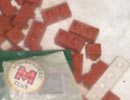
Take Over and Decline
Malcolm Hanson
Directly following Arnold's death Moss became the managing director. But he never possessed his brother's drive or business skills and in 1959 the Levy family's controlling interest in I.T.S. was bought out by Colstons Ltd. Sir Charles Colston had made his fortune building up the Hoover firm in Britain after the war. However, he eventually fell out with Hoover 5 American owners and set up in business himself manufacturing 'white' goods, particularly dishwashers. I.T.S. fitted into his operations because it gave him a means of manufacturing rubber hoses and mountings for his electrical goods.
Production methods at I.T.S. were carefully scrutinised to find ways of reducing costs. Minibrix was an especially labour-intensive product. Each brick was moulded individually and emerged from the moulds with a ring of waste rubber (technically known as 'spew') around the top and bottom of each brick. This was removed by hand in the trimming shop, a process which required eight separate cuts with a pair of scissors and for which, before the war, the 'girls' in the shop were paid the magnificent sum of 2.5d per 100! Attempts had been made to get around this problem by freezing the bricks and then rolling them in a drum so that the spew was knocked off. Unfortunately this process knocked the lugs off as well and tended to round off the crisp edges of the bricks. However the new management was determined to make economies and a new manufacturing process was introduced. Several bricks were now moulded at once in a 'pad' and the pad was then cut into separate bricks afterwards. Unfortunately the bricks were no longer identical and when walls were built with them they did not fit together as precisely as they had done previously.
Other radical changes were made. Tudor Minibrix were dropped entirely along with base plates, individual roof tiles and purlins. Corinthian pillars also went to be replaced by rather cheap and nasty plastic versions called ‘supporting poles’ with a length six times that of the previous pillars. The doors and windows were revised so as to bring them more up to date in appearance. A larger 'picture' window was added along with a set of garage doors. The sets were also completely revised. They were reduced in number to just four main ones called the Starter, Premier, Super and De Luxe. (But even the largest of these was only about the size of the old No. 4 set.) There were three accessory sets; nos. 0, 1 and 2; which, respectively, converted a Starter to a Premier, a Premier to a Super, and a Super to a De Luxe. The sets came in cardboard tubes in which the parts were simply packed in plastic bags, which prevented the sets being displayed attractively as had previously been possible. The new manual was just 14 pages long with a revised range of rather uninspired models. All this amounted to great come down for the system, but not a surprising one given the years of neglect that had proceeded.
Diversification in the toy market was also tried under a new sales manager, one Mr Rudkin. He decided to buy in dolls, which were packed in transparent plastic tubes and sold under the name 'Miss Minibrix’. I.T.S. had a facility for manufacturing tubular metal items at this time and Rudkin used it for the production of a go-kart, rocking-cart and frame for a small swimming pool. All these items were sold with the pre-fix 'Mini' and in fact in 1960 the name ‘Premo’ was dropped altogether and replaced by ‘Minibrix Ltd’ for the purposes of all toy sales. At first these products proved quite successful but a fire in the works in 1961 effectively put paid to these other ventures.
As far as Minibrix itself was concerned the competition from plastic building toys, particularly Lego, must by now have been fierce and the changes to the system can have done little to further its cause. In a final desperate attempt to update the system Rudkin introduced several crude plastic parts, which were not made by I.T.S. These included trees, flowers, window boxes, hanging lamps, a sundial and balconies complete with canopies. They were sold in a newly introduced range of twenty-two Minibrix Extra sets, priced from 1/11 to 4/11, some of which also include standard rubber parts. In an effort to attract even younger builders Toddlers set was also introduced along with Rainbow versions of the Starter and Premium sets. These latter contained coloured bricks of the kind available in the old Junior set.


